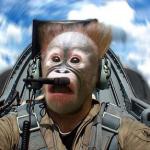Réactions suite au tonneau barriqué en meeting exécuté par l'ATR 42 ...
ATR may have been damaged in 'barrel roll' Danish civil aviation administration SLV is awaiting a detailed statement from regional airline Cimber Air after suspecting that one of its ATR 42-500 turboprops exceeded flight limits by performing a 360° longitudinal roll. Investigations began when the Danish authority was notified of the manoeuvre on 10 May, the day after it was carried out at Sonderborg, where Cimber Air is based.
Sources familiar with the incident say that Cimber Air managing director Jorgen Nielsen was at the controls with one other pilot. No-one else was on board. The sources claim the crew had been preparing for Denmark's Karup air show on 8 June, although it is unclear whether the roll was intended to be part of the display.
Sequences of images of the incident appear to show the twin-engined aircraft travelling at low level - perhaps under 100ft (30m) - with its undercarriage raised, before entering a right-hand climbing turn, inverting and completing the roll recovery.
The climb is indicative of a "barrel" roll, a manoeuvre more complex than a basic aileron roll because it requires constant changes, in all three axes, to the aircraft's direction of travel.
Cimber Air would not discuss the event. SLV says that it is to conduct an assessment and is awaiting a report from the airline, expected shortly, which will include cockpit-voice and flight-data recorder information.
SLV does not have confirmation of the height of the ATR or the extent of the aerodynamic forces involved. It says: "We suspect, although only on the basis of initial information, that the aircraft had been flown outside its operational envelope."
ATR could not immediately comment on the incident.
Following the incident the ATR was taken to Eindhoven in the Netherlands to undergo a structural inspection.
"We'll need some time to make a thorough report on the incident and assess whether there were stress factors on the airframe," says the SLV, cautioning that a sequence of photographs can be misleading.
The aircraft, serial number 501, is a 12-year-old example that was previously on lease to Middle Eastern operator Oman Air, and was still carrying much of the airline's colour scheme at the time.
SLV believes the aircraft was on its way back to airline service with Cimber Air, but that it had still to be brought up to full operational specifications.
The SLV cannot say whether any regulations might have been broken until it has had a chance to study the data and the airline's report.
Source : http://www.flightglobal.com/articles/2008/05/16/223759/atr-may-have-been-damaged-in-barrel-roll.htmlL'article a peut-être tendance comme à l'habitude à transformer quelque chose qui sort un peu de l'ordinaire en un évènement marquant, cela-dit, cette figure n'est pas passée inaperçue ...
Pour avoir fait des tonneaux barriqués à faible taux de roulis en Cap 10 (disons plus de 7 ou 8 sec), il n'est vraiment pas évident de rester dans des facteurs de charge et vitesses corrects. Surtout quand il n'y a pas beaucoup d'eau sous la quille, car cela oblige à tirer plus fermement sur le manche dans le dernier quart de la rotation, pour ne pas se retrouver cloué dans le sol ...
C'est ce qui me fait douter des capacités d'un avion d'aéroclub (type DR400) a pouvoir faire un tonneau barriqué en restant dans les limites du domaine de vol. Et quand je vois de vieux pilotes (au sens où ça fait longtemps qu'ils pratiquent) me raconter qu'à "leur" époque, ils tournaient des tonneaux barriqués sur la plupart de leurs avions, je me pose des questions.
Enfin, on en revient toujours à la même histoire : bien exécuté, ça passe, mais dès lors qu'on sort du cadre de ce qu'on souhaitait faire, ça peut rapidement tourner mal.
Pour en revenir à l'ATR, je ne connais pas son taux de roulis, mais d'après ce que j'ai pu voir en meeting, il n'est pas plus maniable qu'un quelconque autre avion de transport.
On est loin, je pense, des démos de l'avion militaire italien de transport de troupes, l'Alenia C-27J dont le taux de roulis est ici bien supérieur aux avions de cette taille :

Tonneau (à 40 sec)
http://uk.youtube.com/watch?v=H4LfrmjM9hw
Le tonneau qu'il exécute n'est que très peu barriqué, à l'inverse de l'ATR dont on voit bien dans les photos les importantes variations d'assiettes et changement de trajectoire durant la rotation.






 )
)





